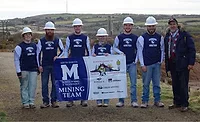South Dakota Mines Team Develops Virtual Reality Training
Aim is to Improve Safety Hazard Instruction

A team at Rapid City, South Dakota-based South Dakota Mines has developed a virtual relative (VR) training module that mimics a mining environment.
“We are using new technologies combined with neuroscience to help people learn faster and more effectively,” says Clint Kling, a mining engineering doctoral graduate student currently working on the project under the guidance of Associate Professor Purushotham Tukkaraja, Ph.D.
The work is in collaboration with a company called Motive.io, with research funded by a $100,000 grant from the United States Department of Labor, Mine Safety and Health Administration (MSHA). The project aims to improve safety hazard instruction.
The VR hazard awareness training was designed for new and inexperienced miners, and will be available in English or Spanish. It will be conducted alongside the already existing MSHA training program at South Dakota Mines, the local mine sites, and will also be used in MSHA’s refresher training courses. The team plans to develop this program at the local level to establish good results before a national rollout.
Researchers plan to take their ideas to the marketplace, and remain open to collaboration with partners in mining, construction or general industry interested in developing a new VR safety training program designed for their needs.
“There is much thought in the background detail that goes into every move and interaction in the environment to give the end-user the most effective and beneficial training,” Kling says.
“A successful VR training module is in the creation of its storyboard,” Tukkaraja adds. “We are pleased that MSHA gave us the opportunity to develop our idea to help make the mining world a better and safer place to work.”
The team saw traditional mining workplace safety as an overly complex subject difficult to convey in a classroom or even on-the-job setting due to the potential dangers involved. The VR training aims to simplify the topic. Allowing people to train in a risk-free environment, the team says, improves safety training outcomes by creating more conscious workers.
“Having trained in VR ensures the person's safety but also shows them the potential hazards of a mining environment. We see the benefits of VR for safety training and the future of it as well. Our goal is to develop a lasting training program using VR because of its proven effectiveness,” Tukkaraja says.
South Dakota Mines, founded in 1885, is a leading engineering, science and technology university based in Rapid City, S.D. It offers bachelor’s, master’s and doctoral degrees in a range of mining and geology-related disciplines. For more information, visit www.sdsmt.edu.
Looking for a reprint of this article?
From high-res PDFs to custom plaques, order your copy today!





